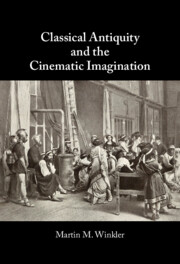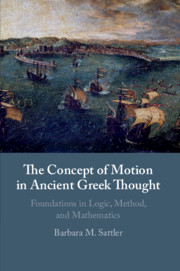Refine search
Actions for selected content:
61 results
Chapter 10 - Emerson and Hinduism
-
- Book:
- Emerson, the Philosopher of Oppositions
- Published online:
- 20 November 2025
- Print publication:
- 22 January 2026, pp 179-197
-
- Chapter
- Export citation
Chapter 9 - Emerson’s Natures
-
- Book:
- Emerson, the Philosopher of Oppositions
- Published online:
- 20 November 2025
- Print publication:
- 22 January 2026, pp 165-178
-
- Chapter
- Export citation
Introduction
-
- Book:
- American Performance in 1976
- Published online:
- 27 November 2025
- Print publication:
- 11 December 2025, pp 1-43
-
- Chapter
- Export citation
Introduction
-
- Book:
- Proclus on Aristotle on Plato
- Published online:
- 05 June 2025
- Print publication:
- 19 June 2025, pp 1-22
-
- Chapter
-
- You have access
- Open access
- HTML
- Export citation
Climate change on a fluid earth: The movement of matter in the spaces of global politics
-
- Journal:
- Review of International Studies / Volume 51 / Issue 5 / September 2025
- Published online by Cambridge University Press:
- 04 April 2025, pp. 906-923
- Print publication:
- September 2025
-
- Article
-
- You have access
- Open access
- HTML
- Export citation
Numbers skyrocket in English but increase in Spanish: metaphoric conceptualization and manner expression in translations
-
- Journal:
- Language and Cognition / Volume 17 / 2025
- Published online by Cambridge University Press:
- 20 March 2025, e41
-
- Article
-
- You have access
- Open access
- HTML
- Export citation
Introduction
-
- Book:
- British Romanticism and the Matter of Voice
- Published online:
- 16 January 2025
- Print publication:
- 23 January 2025, pp 1-16
-
- Chapter
- Export citation
8 - Faces
-
- Book:
- Polytopes and Graphs
- Published online:
- 14 March 2024
- Print publication:
- 21 March 2024, pp 340-393
-
- Chapter
- Export citation

Classical Antiquity and the Cinematic Imagination
-
- Published online:
- 15 February 2024
- Print publication:
- 22 February 2024
Chapter 1 - Motives, Mediation and Motion
-
-
- Book:
- Agency and Transformation
- Published online:
- 23 November 2023
- Print publication:
- 30 November 2023, pp 1-34
-
- Chapter
- Export citation
4 - Time in Space
-
- Book:
- Time, Metaphor, and Language
- Published online:
- 09 November 2023
- Print publication:
- 23 November 2023, pp 50-81
-
- Chapter
- Export citation
Chapter 6 - Action and Passion
- from Part I - The Elements of Paradigm Instances of Efficient Causation
-
- Book:
- Aquinas on Efficient Causation and Causal Powers
- Published online:
- 11 November 2022
- Print publication:
- 11 August 2022, pp 158-188
-
- Chapter
- Export citation

Aristotle's On the Soul
- A Critical Guide
-
- Published online:
- 06 January 2022
- Print publication:
- 20 January 2022
5 - Spinoza on Natural Science and Methodology
-
-
- Book:
- The Cambridge Companion to Spinoza
- Published online:
- 14 October 2021
- Print publication:
- 28 October 2021, pp 187-233
-
- Chapter
- Export citation
Chapter 7 - The Ontology of Bodily Human Acts
- from Part III - Act Hylomorphism
-
- Book:
- Thomas Aquinas on the Metaphysics of the Human Act
- Published online:
- 25 June 2021
- Print publication:
- 08 July 2021, pp 147-177
-
- Chapter
- Export citation
Chapter 5 - Begotten and Made
-
-
- Book:
- Cosmology and Biology in Ancient Philosophy
- Published online:
- 21 May 2021
- Print publication:
- 10 June 2021, pp 85-100
-
- Chapter
- Export citation
2 - Science in the Long Eighteenth Century
-
-
- Book:
- The Cambridge Companion to Eighteenth-Century Thought
- Published online:
- 15 June 2021
- Print publication:
- 20 May 2021, pp 58-97
-
- Chapter
- Export citation
Chapter 10 - Language
- from Part I - Contexts
-
-
- Book:
- Shakespeare and Emotion
- Published online:
- 01 October 2020
- Print publication:
- 22 October 2020, pp 151-166
-
- Chapter
- Export citation
Introduction
-
-
- Book:
- Shakespeare and Emotion
- Published online:
- 01 October 2020
- Print publication:
- 22 October 2020, pp 1-16
-
- Chapter
- Export citation

The Concept of Motion in Ancient Greek Thought
- Foundations in Logic, Method, and Mathematics
-
- Published online:
- 28 September 2020
- Print publication:
- 08 October 2020
